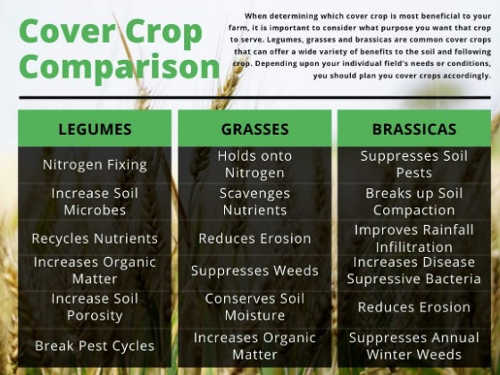By Jarrod Miller
As fall approaches, it is time to start thinking about your cover crop choices. There are three main categories of cover crops: legumes, grasses, and brassicas. Making the decision on which one is right for your operation should be based your current field conditions, management, and expected outcomes. Each category of cover crop has varying benefits that could help to increase yields, improve soil health, and decrease input costs the following planting season.

If adding nitrogen to your soil were something you seek from a cover crop, legumes or a legume mix would be worth considering. Legumes are well known for nitrogen fixation, where nearly two thirds of the nitrogen fixed by legumes can be utilized by the following crop. This increase in N can not only cut down on input costs, but can also lead to an increase in soil microbes, which help break down the carbon-rich fodder left over from last year. Legumes are also a viable option for a cover crop due to their ability to increase soil organic matter, recycle nutrients, and break-up weed and disease presence after grass-type crops.
Grasses also have the ability to provide additional N in your soil and other nutrients due to their scavenging abilities. Their root systems are extensive and establish rapidly, helping to decrease erosion and suppress weeds. Large amounts of biomass are produced by grasses, which ultimately helps add organic matter to the soil. However with grass cover crops it is necessary to be aware of the high C:N ratio at maturity. Residues with high C:N ratios (>30) may tie up N instead of making it available to grain crops. To avoid this problem, terminate the grass crop before maturation or supply additional N.
If soil compaction is a prominent issue, brassicas are able to penetrate through compacted soils with their large taproots, allowing for the next crop to root deeper. Some brassicas will winterkill and decompose by the spring, which helps to aerate the soil and improve rainfall infiltration. Additionally, brassicas like mustards and oilseed radishes are attractive to pollinators and other beneficial insects.
When considering a cover crop, it’s important to consider all ecological and biological aspects that your farm or field could benefit from. Making the decision to plant a cover crop is a step towards increasing soil health, improving yields and decreasing input costs.